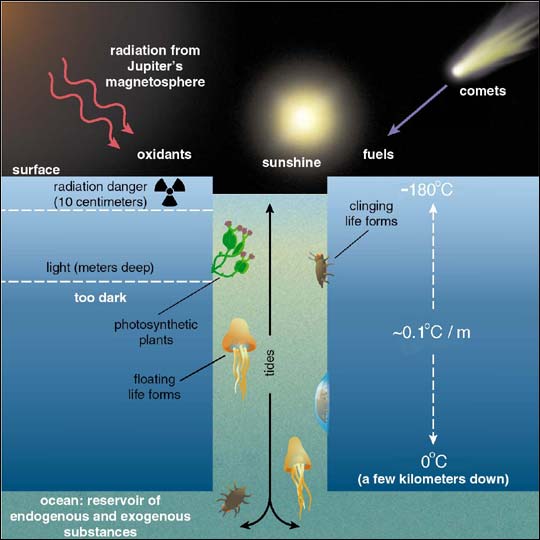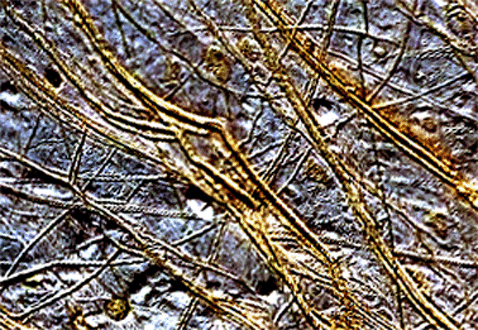It looks like you're using an Ad Blocker.
Please white-list or disable AboveTopSecret.com in your ad-blocking tool.
Thank you.
Some features of ATS will be disabled while you continue to use an ad-blocker.
2
share:
The Galileo spacecraft and its Inertial Upper Stage booster rocket
being deployed from the space shuttle Atlantis October 18, 1989.
Image Courtesy: NASA/JPL
Jupiter’s Moon, Europa.
Courtesy: NASA
In our quest for seeking out life on Mars, we seem to have forgotten Europa, Jupiter’s fourth largest Moon. Europa has some lines and crevasses, but scarcely any of those unsightly craters or disfiguring bumps that scar most moons.
Prior to the Galileo mission, scientists' knowledge of Europa was simply a small ice- covered moon with an extremely bright surface covered by faint but strange markings.
Now, scientists see evidence of a young and thin, cracked and ruptured ice shell, probably moving slowly over the surface of a briny ocean that is 100 kilometers (62 miles) or more deep.

Europa and an enlargement of the Thrace region.
Courtesy: Arizona State University.
Europa has become recognized as a potential habitat for extraterrestrial life and is now an important target for future solar system exploration.
Even when Europa's surface shapes are strengthened by shadows, it's still strangely smooth for a solar system satellite. Compare Europa to Mars, which has 450 craters larger than 100 kilometers in diameter!
That may be because Europa seems to be resilient as its smooth surface may rest on a giant subterranean ocean. Detailed photos taken by the satellite Galileo leads one to believe so. Does this frozen moon contain the largest ocean in the solar system? And if so, could life exist beneath this deeply frozen surface?
A possible scenario for life on Europa.
Image credit: Richard Greenberg
Brown University planetary geologist James Head, a long-time student of Europa, says that liquid water may exist despite the frigid conditions in Jupiter's neighborhood. Europa's insides may be warmed by the interaction between Jupiter's immense gravity and the gravity of Europa and other moons.
And those surface cracks you notice on Europa probably occur when slushy ice or water wells up from below and shoulders the ice aside. Head says the upwards movement causes those ridges that parallel the cracks. Well, that’s the theory anyway. Could these parallel lines / fissures / crevasses be something else?
Subsurface Environments
According to a paper, Expanding and Improving the Search for Habitable Worlds by AM Mandell that I found in the Los Alamos National Laboratory Archives, in subsurface environments of planetary bodies and moons, the local temperature is defined by heat transfer through the planet’s interior, the heat source being either internal latent heat from accretion or an external force such as tidal compression, while cooling is limited by insulation from the surface layers.
The decay of radioactive isotopes may be enough to maintain liquid water in a subsurface layer in the absence of additional heat sources. Heat can also be generated by tidal forces in moons orbiting a giant planet.
As the moon travels closer to and farther from the parent planet, the change in gravity causes it to expand towards the giant planet. The internal structure of the moon continually compresses and expands, creating frictional heating that can be conducted throughout the moon. This heat may also be sufficient to maintain mantle convection and subsurface liquid water (a possibility on Europa).
So then, does the evidence of a liquid ocean on Jupiter's moon Europa indicate that this moon houses extraterrestrial life? Europa's surface is covered with frozen water at a nippy -150 C. The coldest place on Earth is Vostok at -89 C. Not much colder! So if there’s life in Vostok, what is the possibility of alien life forms inhabiting Europa’s oceans?
Lake Vostok
Lake Vostok was first discovered by the Russians, who have the only research station in the area with Russian scientists working with an ice-core drilling program as part of a well recognized scientific glaciology study, which started in 1989.
The station was a site of an international project to drill down into the ice just above the lake. This yielded the deepest ice core ever recorded, reaching a depth of 3,623 meters. The results of the analyses were:
S.S.Abyzov of the Russian Academy of Sciences in Moscow has found bacteria, yeasts, fungi, algae, and even pollen grains in the Vostok ice core going to depth of 2,750 meters, i.e. three quarters of the way to the bottom. Some of these organisms are alive and capable of growing.
The results of this analysis indicates the survivability of organisms in a body of water devoid of any light and will certainly help to learn more about how life can survive under extreme conditions on other planets on moons.
This last issue is a matter of particular interest to NASA. The agency is taking a close interest in Lake Vostok because it is keen to develop technologies that might help in the search for life on extraterrestrial worlds. Lake Vostok is thought to be a very good terrestrial analogue to the conditions on Europa, a moon of Jupiter which is thought to hold a large liquid ocean far beneath its frozen surface. If microbial life can exist in Vostok, then it also might thrive on Europa!
And then, if Europa does and did harbor life from billions of years in the past, could it not have evolved into intelligent life forms due to natural evolutionary processes after all these millennia, deep under the ice sheets? Take a look at Europa’s surface in the pics below. Absolutely parallel lines, and other strange geometric shapes! Resembles a nice little cityscape like downtown LA!! Did I mean it’s a city of aliens? No! But it sure looks fascinating all the same!
Or are we not being told everything?
Images courtesy: JPL/NASA
Cheers!
arxiv.org...
whyfiles.org...
www.daviddarling.info...
solarsystem.nasa.gov...
www.unspecial.org...
www2.jpl.nasa.gov...
www2.jpl.nasa.gov...
new topics
-
An Interesting Conversation with ChatGPT
Science & Technology: 2 hours ago
2





